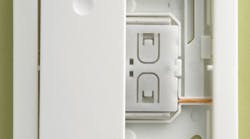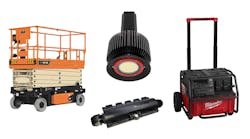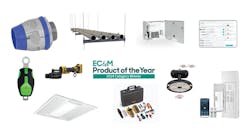Imagine having the freedom to place a light switch wherever it best suits your lifestyle — next to your bed, within reach of your preschooler's grasp, or on the side of your elderly parent's wheelchair. Although this may sound like technology of the future, it's actually a component of a whole-house lighting control system recently developed by Winston-Salem, N.C.-based Verve Living Systems, a Masco Corp. brand.
“A team of our engineers came upon an energy harvesting radio frequency technology while attending a trade show,” says Dianne Pisarek, vice president responsible for Verve Living Systems. “This technology is marketed by EnOcean, which is a spin-off of Siemens Corp., and it's the core of Verve's lighting control system.”
The term “energy harvesting” refers to the product's ability to generate enough energy to transmit radio signals across distances as great as 300 feet simply by turning a switch on or off. Comprised of controllers, sensors, and switches, the system uses radio frequency emissions to control light fixtures and receptacles.
“Because the switches generate their own power, the need for batteries is eliminated,” notes Pisarek. “This not only lowers the cost of system maintenance, it also makes the product more environmentally friendly.”
Each controller can manage up to 10 loads, and is hardwired to line voltage and to traditional lighting fixtures and receptacles. For the average 3,000-square-foot home, this means four or five controllers are required. The number of switches provided depends on how many the homeowner desires. Switches can be programmed to operate one light, several lights, or every light in the house, giving users the ability to set unlimited lighting scenes as well as pathway lighting.
“In essence, every switch functions like a remote control,” explains Pisarek. “They are manufactured with a docking plate on the back, which can be screwed, nailed, thumb tacked, or even glued to a wall. Furthermore, they can adhere to any surface, including glass, brick, stone, tile, and wood.”
In addition, each switch can operate as a dimmer. Compared to a traditional residential electrical system, the company says the product requires less copper wire and eliminates the need for wall boxes, wire connectors, and conduit (if required) associated with traditional hard-wired switches. The system also supports switched outlets, which simplifies turning off power to phantom loads, such as computers, stereos, and DVD players.
“This product takes less time to install than traditional systems because it uses less wire,” says Tom Boston, owner of Clarkston, Mich.-based Boston Electric, who has installed the system. “It also makes remodel work easier. If a customer wants me to move a light switch, I don't have to fish wires through walls anymore. Plus, programming is simple enough for homeowners to perform themselves, and it only takes only a couple of minutes.”
Pricing for the system varies, depending on the number of loads needed per home. According to Pisarek, for a typical 3,000-square-foot residence, the system's components cost between $3,000 and $3,500.
For more information on Verve Living System's whole-house lighting control system, visit www.vervelivingsystems.com.




